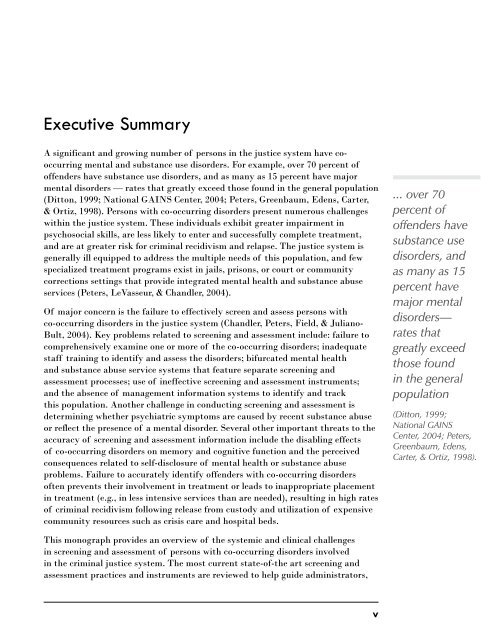Screening and Assessment of Co-Occurring Disorders in the Justice ...
Screening and Assessment of Co-Occurring Disorders in the Justice ...
Screening and Assessment of Co-Occurring Disorders in the Justice ...
Create successful ePaper yourself
Turn your PDF publications into a flip-book with our unique Google optimized e-Paper software.
Executive SummaryA significant <strong>and</strong> grow<strong>in</strong>g number <strong>of</strong> persons <strong>in</strong> <strong>the</strong> justice system have cooccurr<strong>in</strong>gmental <strong>and</strong> substance use disorders. For example, over 70 percent <strong>of</strong><strong>of</strong>fenders have substance use disorders, <strong>and</strong> as many as 15 percent have majormental disorders — rates that greatly exceed those found <strong>in</strong> <strong>the</strong> general population(Ditton, 1999; National GAINS Center, 2004; Peters, Greenbaum, Edens, Carter,& Ortiz, 1998). Persons with co-occurr<strong>in</strong>g disorders present numerous challengeswith<strong>in</strong> <strong>the</strong> justice system. These <strong>in</strong>dividuals exhibit greater impairment <strong>in</strong>psychosocial skills, are less likely to enter <strong>and</strong> successfully complete treatment,<strong>and</strong> are at greater risk for crim<strong>in</strong>al recidivism <strong>and</strong> relapse. The justice system isgenerally ill equipped to address <strong>the</strong> multiple needs <strong>of</strong> this population, <strong>and</strong> fewspecialized treatment programs exist <strong>in</strong> jails, prisons, or court or communitycorrections sett<strong>in</strong>gs that provide <strong>in</strong>tegrated mental health <strong>and</strong> substance abuseservices (Peters, LeVasseur, & Ch<strong>and</strong>ler, 2004).Of major concern is <strong>the</strong> failure to effectively screen <strong>and</strong> assess persons withco-occurr<strong>in</strong>g disorders <strong>in</strong> <strong>the</strong> justice system (Ch<strong>and</strong>ler, Peters, Field, & Juliano-Bult, 2004). Key problems related to screen<strong>in</strong>g <strong>and</strong> assessment <strong>in</strong>clude: failure tocomprehensively exam<strong>in</strong>e one or more <strong>of</strong> <strong>the</strong> co-occurr<strong>in</strong>g disorders; <strong>in</strong>adequatestaff tra<strong>in</strong><strong>in</strong>g to identify <strong>and</strong> assess <strong>the</strong> disorders; bifurcated mental health<strong>and</strong> substance abuse service systems that feature separate screen<strong>in</strong>g <strong>and</strong>assessment processes; use <strong>of</strong> <strong>in</strong>effective screen<strong>in</strong>g <strong>and</strong> assessment <strong>in</strong>struments;<strong>and</strong> <strong>the</strong> absence <strong>of</strong> management <strong>in</strong>formation systems to identify <strong>and</strong> trackthis population. Ano<strong>the</strong>r challenge <strong>in</strong> conduct<strong>in</strong>g screen<strong>in</strong>g <strong>and</strong> assessment isdeterm<strong>in</strong><strong>in</strong>g whe<strong>the</strong>r psychiatric symptoms are caused by recent substance abuseor reflect <strong>the</strong> presence <strong>of</strong> a mental disorder. Several o<strong>the</strong>r important threats to <strong>the</strong>accuracy <strong>of</strong> screen<strong>in</strong>g <strong>and</strong> assessment <strong>in</strong>formation <strong>in</strong>clude <strong>the</strong> disabl<strong>in</strong>g effects<strong>of</strong> co-occurr<strong>in</strong>g disorders on memory <strong>and</strong> cognitive function <strong>and</strong> <strong>the</strong> perceivedconsequences related to self-disclosure <strong>of</strong> mental health or substance abuseproblems. Failure to accurately identify <strong>of</strong>fenders with co-occurr<strong>in</strong>g disorders<strong>of</strong>ten prevents <strong>the</strong>ir <strong>in</strong>volvement <strong>in</strong> treatment or leads to <strong>in</strong>appropriate placement<strong>in</strong> treatment (e.g., <strong>in</strong> less <strong>in</strong>tensive services than are needed), result<strong>in</strong>g <strong>in</strong> high rates<strong>of</strong> crim<strong>in</strong>al recidivism follow<strong>in</strong>g release from custody <strong>and</strong> utilization <strong>of</strong> expensivecommunity resources such as crisis care <strong>and</strong> hospital beds.... over 70percent <strong>of</strong><strong>of</strong>fenders havesubstance usedisorders, <strong>and</strong>as many as 15percent havemajor mentaldisorders—rates thatgreatly exceedthose found<strong>in</strong> <strong>the</strong> generalpopulation(Ditton, 1999;National GAINSCenter, 2004; Peters,Greenbaum, Edens,Carter, & Ortiz, 1998).This monograph provides an overview <strong>of</strong> <strong>the</strong> systemic <strong>and</strong> cl<strong>in</strong>ical challenges<strong>in</strong> screen<strong>in</strong>g <strong>and</strong> assessment <strong>of</strong> persons with co-occurr<strong>in</strong>g disorders <strong>in</strong>volved<strong>in</strong> <strong>the</strong> crim<strong>in</strong>al justice system. The most current state-<strong>of</strong>-<strong>the</strong> art screen<strong>in</strong>g <strong>and</strong>assessment practices <strong>and</strong> <strong>in</strong>struments are reviewed to help guide adm<strong>in</strong>istrators,v



